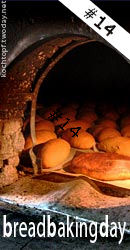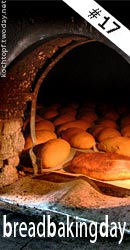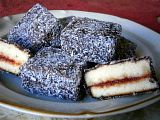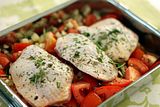
Grape Leaves Stuffed with Ground Meat and Rice with Apricot Tamarind Sauce/ Yebra
Adapted from Aromas of Aleppo by Poopa Dweck and Michael J. Cohen. Published by Harper Collins, 2007
Yield: 6 to 8 servings
Ingredients for hashu/filling:
1 pound (455 gm) ground (minced) beef
1/3 cup (80 ml) (2 1/3 oz) (65 gm) short grain rice
1 teaspoon (5 ml) (6 gm) all spice
2 tablespoons (30 ml) vegetable oil
1 teaspoon (5 ml) (6 gm) cinnamon
1 teaspoon (5 ml) (3 gm) kosher (coarse) salt **if using regular table salt only use ½ tsp.**
¼ teaspoon (1¼ ml) (1½ gm) white pepper
1 onion, chopped **optional**
1 cup (5½ oz) (150 gm) pine nuts **optional**
Directions:
1.Soak rice in water, enough to cover, for 30 minutes. Combine meat, rice, allspice, vegetable oil, cinnamon, salt, white pepper, and if desired, onion and pine nuts, in a large mixing bowl. Mix well.
Ingredients for assembly:
1 pound (455 gm) hashu/filling (see recipe above)
36 preserved grape leaves, stems trimmed, drained, rinsed and patted dry
1 tablespoon (15 ml) vegetable oil
6 dried apricots – or more if you desire
3 tablespoons (45 ml) tamarind concentrate **if you can’t find it, you can omit it**
¼ cup (60 ml) freshly squeezed lemon juice
1 tablespoon (15 ml) (9 gm) kosher (coarse) salt **if using regular table salt only use 1.5 tsp.**
Notes:
If using grape leaves preserved in brine, to remove salt put them in a bowl and pour boiling water over them. Make sure that the water penetrates well between the layers, and leave them soaking for about twenty minutes, then change the water a time or two using fresh cold water.
If using fresh leaves, plunge a few at a time in boiling water for a few seconds only, until they become limp, and lift them out.
Tamarind is actually fairly easy to find. There is a paste that is in package already made up. You can find it at Asian, Mexican or Indian grocers. You can also find the pods (a little more difficult) and make it yourself. It is akin to a sweet/tangy tea flavor. If you can’t find it, you can skip the sauce all togheter. The grape leaves will be just as delicious without the sauce. But we hope that those that can find it will use it.
Directions:
1.Place a grape leaf on a flat surface, vein side up. You can trim the little stem if you would like.
2.Place about two teaspoons (10 ml) of the filling in the center of the leaf, near the stem edge.
3.Roll the leaf end to end, starting from the stem edge. As you roll, fold the sides of the leaf in toward the center. The leaf should resemble a small cigar, about 2 to 2 1/2 inches (50 mm to 65mm) long.
4.Repeat with the remaining leaves and filling.
a.(You can freeze the stuffed grape leaves at this point. Just line a baking sheet with wax paper. When firmly frozen, transfer to an airtight plastic bag place back in the freezer.)
5.In a medium saucepan put in the vegetable oil and then place the filled grape leaves in the pot.
6.Place apricots in between the stuffed grape leaves. Cover and cook over low heat for 5- 8 minutes or until the grape leaves begin to sweat.
7.Using all three tablespoons, place a little of the tamarind concentrate, if using, over the rolls.
8.Combine lemon juice, salt, and water then add to pan, filling it ¾ full.
9.Weigh down the grape leaves with a heat proof plate or board to prevent them from unraveling. Cover and bring to a boil over medium high heat. Reduce the heat to low and simmer for about 40 minutes.
a.Alternatively, place the saucepan in an oven preheated to moderate 350°F/180°C/gas mark 4 and cook for an hour.
10.Spoon cooking liquid over the grape leaves occasionally. You will know they are done, when the grape leaves are neither soupy nor dry.
11.Tilt pan sideways over serving platter, allowing the grape leaves to tumble out. Try not to handle them individually to reduce unraveling.
a.Alternately you can try spooning them out very gently.
Wara Einab or Dolma/Cold Stuffed Grape Leaves
Adapted from Claudia Roden's The New Book of Middle Eastern Food a Borzoi Book, published by Alfred A. Knopf
Yield: 6 to 8 servings
Ingredients
24 – 30 preserved or fresh grape leaves.
1¼ cups (300 ml) (9 oz) (250 gm) long grain rice
1- 3 tomatoes, peeled and chopped
1 large onion, finely chopped or 4 tablespoons (60 ml) (35 gm) finely chopped scallions
2 tablespoons (30 ml) (25 gm) finely chopped flat leaf parsley
2 tablespoons (30 ml) (15 gm) crushed dried mint
¼ teaspoon (1¼ ml) (1½ gm) ground cinnamon
¼ teaspoon (1¼ ml) (1½ gm) ground allspice
1 teaspoon (5 ml) (6½ gm) dill
Salt and pepper
2 tomatoes, sliced **optional**
3 or 4 cloves garlic
2/3 cup (160 ml) extra-virgin olive oil
1 teaspoon (5 ml) (5 gm) sugar
Juice of 1 lemon or more
Notes:
If using grape leaves preserved in brine, to remove salt put them in a bowl and pour boiling water over them. Make sure that the water penetrates well between the layers, and leave them soaking for about twenty minutes, then change the water a time or two using fresh cold water.
If using fresh leaves, plunge a few at a time in boiling water for a few seconds only, until they become limp, and lift them out.
Directions:
1.Pour boiling water over the rice and stir well, then rinse with cold water and let drain.
2.Mix the rice with the chopped tomatoes, onion or scallion, parsley, mint, cinnamon, allspice, dill, salt and pepper to taste.
3.Place a grape leaf on a flat surface, vein side up.
4.Place about two teaspoons (10 ml) of the filling in the center of the leaf, near the stem edge.
5.Roll the leaf end to end, starting from the stem edge. As you roll, fold the sides of the leaf in toward the center. The leaf should resemble a small cigar, about 2 to 2 1/2 inches (50 mm to 65mm) long.
6.Repeat with the remaining leaves and filling.
a.(You can freeze the stuffed grape leaves at this point. Just line a baking sheet with wax paper. When firmly frozen, transfer to an airtight plastic bag place back in the freezer.)
7.Pack the stuffed leaves tightly in a large pan lined with tomato slices or imperfect grape leaves Place a whole garlic clove in between them for extra flavor. The tightness will help prevent the rolls from unraveling.
8.Mix together olive oil, 2/3 cup (160 ml) water, sugar and lemon juice and pour over the stuffed leaves. Put a small heat proof plate on top of the leaves to prevent them from unwinding, cover the pan and simmer very gently for about 1 hour, until the rolls are thoroughly cooked, adding water occasionally, a cup at a time, as the liquid in the pan becomes absorbed. Cool in the pan before turning out. Serve cold.
There are many variations you can use but here are just a few suggestions:
Add ¼ cup (60 ml) (1½ oz) (45 gm) raisins or currants and ¼ cup (60 ml) (1⅓ oz) (40 gm) pine nuts to the filling.
Mix a pinch or two of powdered saffron with the olive oil and water before pouring over the stuffed grape leaves.
Soak about ¼ cup (60 ml) (1½ oz) (45 gm) dried chickpeas in water overnight. Crush them using a processor or blender and add them to the filling. In this case use ¼ cup (60 ml) (1¾ oz) (50 gm) less rice. You could also use drained canned chickpeas.

























































































.jpg)













.jpg)





































